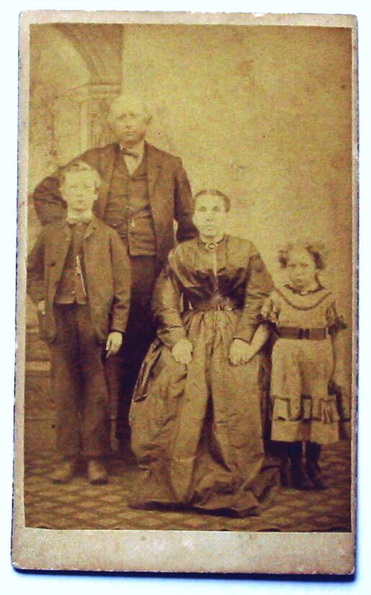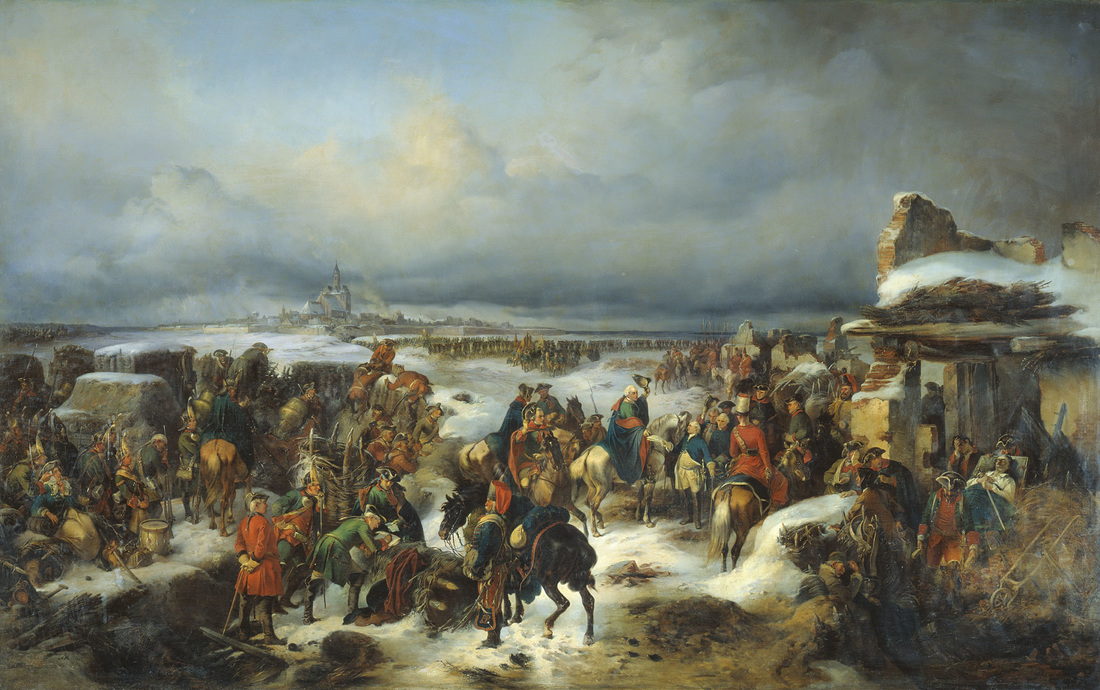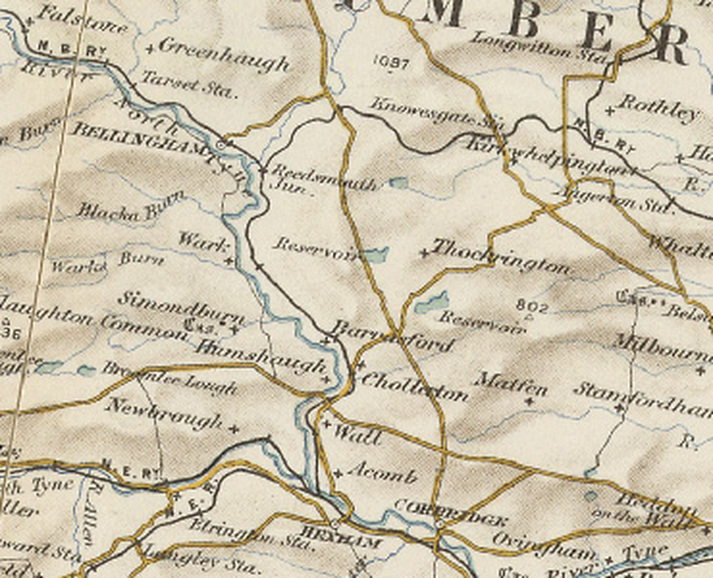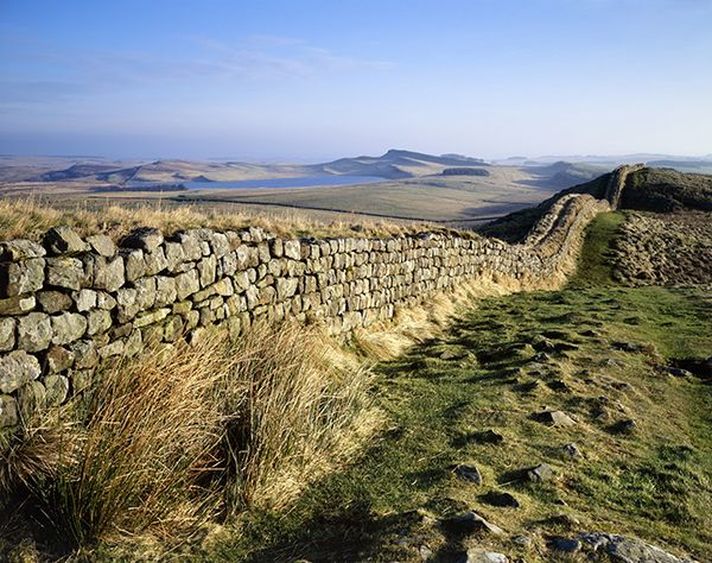IntroductionThis month's blog post comes from the pen of Rosemary Dixon-Smith, a fellow genealogist, based in South Africa who helped me track down my errant Trotter relatives who had emigrated to Natal from Scotland aboard the 'Unicorn' in 1850. Rosemary and I have kept in touch and when she told me of her own Smith family connections in Northumberland, I suggested she share her ancestral journey. Anyone who has faced the prospect of tracking down a 'John Smith' can appreciate how daunting a task this can be on home soil, let alone from the other side of the world! Over to you Rosemary... Smiths of Northumberland - rosemary dixon-smithWhen I began tracing the Smith family line in Northumberland, I did so with some trepidation. Smith is such a commonly-found surname all over the British Isles. The main ancestor about whom I had minimal information was a John Smith – not auspicious at all. And it became clear that the family were Non-conformists, not the easiest records to find. Undeterred, however, and probably because at that stage I was new to family history research, I confronted the challenge and with beginners’ luck gradually managed to establish a fairly reasonable base on which to build. The most important clue about our John Smith was a letter, dated 10 June 1900, written by him to family members in South Africa. The vital point was his address, given as Spring House, Slaley near Hexham. At the time I had no idea how this location would haunt me and how eventually I would travel miles from South Africa to see it for myself. This is an indication of how family history research can take over – and change - one’s life. Another significant and helpful remark made in the letter was the ages of John Smith and his wife – with the address this would enable me to track them down in various Census records The reason for John Smith sitting down to write his letter was that he had received news of the death of his son, William Dixon Smith, during the Siege of Ladysmith. The Anglo-Boer War was still in its early stages when William, as Lieutenant Quartermaster of the Border Mounted Rifles, had fallen, not on the battlefield, but like many other soldiers, of disease in a hospital camp. William’s stepson, Alexander Anderson, a trooper in the same regiment, had also died of the fever raging through the besieged town. 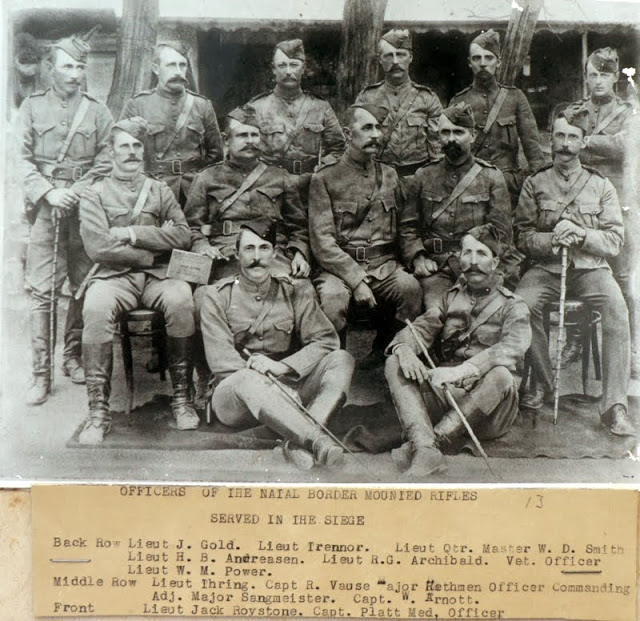 Border Mounted Rifles: officers who served in the Siege of Ladysmith, Anglo-Boer War: Lieut James Gold, Lieut Trennor, Lieut Quarter Master W Dixon Smith, Lieut H B Andreasen, Lieut R G Archibald, Lieut W M Power (Veterinary officer), Lieut Thring, Capt Richard Vause, Maj Rethman (OC), Adj Maj Sangmeister, Capt W Arnott, Lieut Jack Royston, Capt Platt (medical officer) It must have come as a terrible shock to William’s parents to lose their son so far away, in a country he had travelled to hoping to find a new and better life. What made it worse was that his widow, Charlotte, was left with three of their children to bring up alone. She already had five children by her first husband. Charlotte, a courageous and determined Scotswoman, managed to survive her tragedies and to provide admirably for herself and her children. To return to John’s Northumbrian origins, it seemed from Census records that he was born in Colwell. There had been Smiths at Colwell in the parish of Chollerton for so long that John (1821-1903), thought of it as his birthplace but he was actually born on 24 May 1821 at Ogle, a hamlet in Whalton parish, some miles further east, where his parents Richard and Elizabeth Smith were then living. Colwell, however, was the family base and had been as far back as anyone could remember - or even before then, from the early days of the mad old king, George III, whose reign had begun in 1760. Traditionally, in and around Colwell, there were Smiths who were farmers and Smiths who were weavers. Northumberland was sheep-farming country. Richard Smith (William Dixon Smith’s grandfather), born on 28 October 1781, was the son of another John Smith, recorded on the occasion of Richard’s baptism as ‘weaver, at Colwell’. Earlier, in 1762, a John Smith appears on the Militia List for Chollerton parish as ‘webster at Swinburn, Colwell’. All able-bodied men from 18 to 50 in that parish are listed, so this John could have been Richard’s father or grandfather. With the name John Smith it is very difficult to be as accurate as any researcher would wish, and a certain amount of speculation enters the story when going back to John Smith’s parents and grandparents. All that can be said with any degree of certainty is that there were numerous Smith families in Colwell from at least the mid-18th century. The Militia List is a reminder that the Seven Years War was in progress. Britain had been almost continuously at war since 1689: the Nine Years War which had began during King William III’s reign being followed by the wars of the Spanish Succession, then by the wars of the Austrian Succession and those by seven more years of war against France. War was a fact of life. A rural community in the North Tyne valley could not remain untouched by the ripple effect of these conflicts. The army was away fighting on foreign soil and the Militia Act of 1757 had introduced conscription among the local inhabitants to provide a force for national defence – the Home Guard of that era. Every year there would be a ballot from the Militia List to choose men who could be required to serve anywhere in Britain (including Ireland). This was not a popular move and the introduction of the ballot was vigorously opposed. So strong was local feeling that it led to a riot at the market-town of Hexham in 1761. The Gentleman’s Magazine of February 1819, discussing the history of Northumberland, mentioned the tragic event: At Hexham, March 9 1761, a large concourse of people assembled to oppose the ballot for the Militia, when Ensign Hart, and a private of the North Yorkshire Militia being killed, the Magistrates ordered the soldiers to fire, by which 45 of the rioters were slain and 300 wounded. Among the list of killed and wounded was a John Smith of Corbridge who was wounded in the thigh and shoulder. Five Chollerton men were killed in the riot. The story lived on in the neighbourhood for years, no doubt being applied as a landmark date in conversation: ‘That would have been before (or after) Bloody Monday’. It’s impossible to state with any certainty that it was John the webster (i.e. the father or grandfather of the Richard Smith baptised in 1781) who appeared on the Militia List of 1762. It is likely that this was so, and that he may have participated in or been a spectator of the riot in the previous year. The unrest in Hexhamshire was long over by the time Richard Smith was born to John and his wife in 1781. He had at least two older brothers, Thomas, born in 1771, another John, born in 1776, as well as a sister, Mary, born in 1773. A younger brother, George, arrived in 1785. Richard and his siblings were all baptised at the Presbyterian chapel at Bavington, not far from Colwell. This indicates Nonconformist views in the Smith family though it may have been the influence of the children’s mother, whose name is not recorded in the Bavington registers. Looking at Richard’s brief entry one might imagine that John had produced a son without any assistance from a member of the opposite sex: Richard Smith son to John Smith weaver was born at Colwell. Ocbr. 28 – 1781 These baptisms also indicate forenames which emerge in several generations of the family: Thomas, George, Mary and the ubiquitous John. The places mentioned above were all within a fairly narrow radius. Chollerton, a parish of 12,950 acres by 1855, comprised the townships of Barrasford, Chollerton, Colwell and Swinburn, as well as Gunnerton and Chipchase. On Chollerton’s boundaries were the parishes of Bellingham, Corsenside, Wark, Simonburn, St John Lee and Thockrington. Some of these place-names emerge regularly in connection with Smith family events - births, baptisms, marriages and burials. Traversed by Hadrian’s Wall, the area resonates with echoes of Roman Britain. The old Roman Road, Watling Street, passes between Colwell and Great Swinburn where there was a Roman camp. Later the railway would bisect the area in much the same way, through Chollerton, Barrasford and other stations. People lived contentedly, were mobile to a limited extent mainly for occupational reasons, and had no thought of emigrating to another country. Richard Smith was born at Colwell and baptised on 28 October 1781 at Bavington Presbyterian Chapel. The register at this church shows several possible siblings of Richard including 1771 Thomas, 1773 Mary, 1776 John and 1785 George. Clear naming patterns indicate this is the right family and the dates are suitable as well. The non-conformist leanings of the family were already well-established. Richard moved away from Colwell to Whalton parish – perhaps there were too many weavers in the old district or Richard was an itinerant labourer - with his wife Elizabeth nee Nevins and they were living at ‘Oglewellhouse’ at the time of the birth of their first child in 1815. The couple were still in residence there when John Smith was born on 24 May 1821 and was baptised at Thorneyford Presbyterian Chapel. There were some sisters – Mary and Margaret. Another Margaret, born in the same year as John, 1821, arrived at Falstone, the daughter of Adam Little, Mason. Though neither could know it yet, this Margaret and our young John Smith were destined to be married at a future date. This couple would be the parents of William Dixon-Smith born in 1857. The marriage of John Smith and Margaret took place at St Andrew’s Church, Newcastle on 30 December 1844. John is described as son of Richard Smith, labourer, and his occupation is given as blacksmith. There is a Richard Smith, born 1781, a widower of Brandling Place (this address appears on the marriage record above) with a daughter Elizabeth. An Elizabeth Smith is named as one of the witnesses of John and Margaret’s marriage. The same Richard appears in the 1851 Census, birthplace Chollerton, 1781, widower. This all fits in very nicely. It is possible that Brandling Place was a lodging house where Richard Smith and his daughter were living at the time of the wedding John’s bride was the daughter of Adam Little and Jane Telfer. In 1818 the Littles were living at Hawkhope herds’ house in Falstone parish and in 1819 they were at Yarrow in the same parish. In this rural backwater, as the 18th century gave way to the 19th, there was as yet no inkling of the coming of the iron horse, nor of the gradual depopulation of the countryside that would begin as towns and cities became magnets for people of the industrial age. Links
9 Comments
|
AuthorSusie Douglas Archives
August 2022
Categories |
Copyright © 2013 Borders Ancestry
Borders Ancestry is registered with the Information Commissioner's Office No ZA226102 https://ico.org.uk. Read our Privacy Policy
